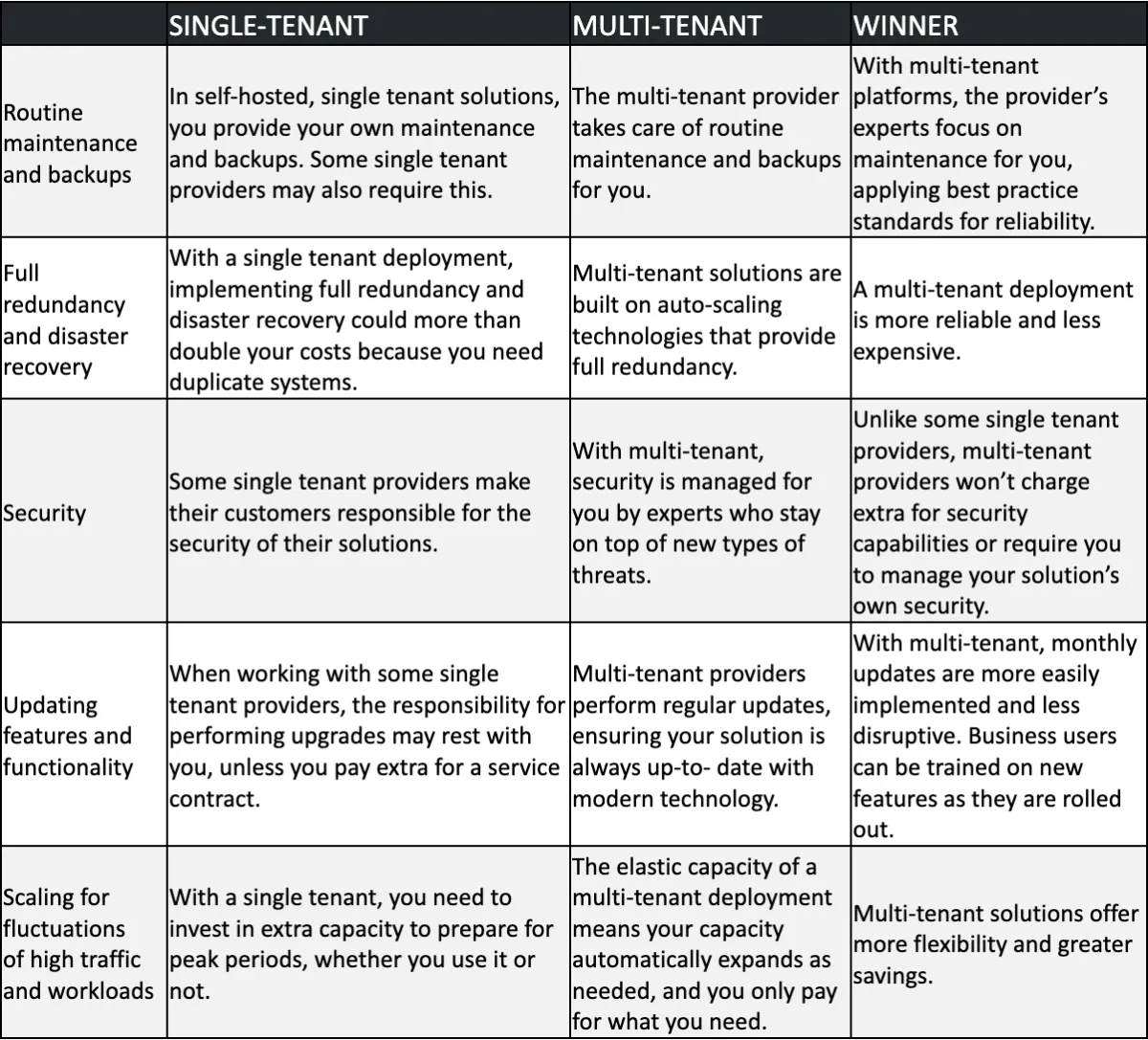
While it’s generally accepted that cloud is the future, clouds still come in many forms, and understanding the respective merits of each can be, well, cloudy, to say the least.
Industry analysts sometimes squabble over the pros and cons of single tenant versus multi-tenant deployment. While single tenant deployment may have been a viable solution for some organisations in the recent past, multi-tenant deployment offers numerous benefits for organisations looking to modernise their operations. As a true cloud-based platform, multi-tenant deployment can offer vast amounts of storage, a speedy implementation, and advanced security capabilities.
Single tenant vs multi-tenant
It’s important to understand the characteristics of these two deployment platforms in order to take note of key differences between them.
Single-tenant architecture typically provides separate software and server resources for each customer. This gives the customer’s enterprise plenty of control over the system, but it also requires more effort and a larger investment than with multi-tenant. Some organisations “lift” their legacy system with all its existing strengths and shortcomings and “shift” it to the cloud in a single-tenant deployment. Unfortunately, this process perpetuates many of the same outdated processes organisations are hoping to evolve away from.
In addition, single-tenant architecture requires the same resource-intensive and expensive upgrade processes as on-premises solutions. Also, the often-rigid structure of a single-tenant deployment limits the extent of changes that can be implemented, which can impede an organisation’s growth.
A multi-tenant environment gives several customers the use of the application within the same operating environment on the same shared hardware. This model provides all the benefits of cloud computing, such as greater agility and security, plus the costs are shared across more business users. This helps reduce the cost for the provider even while it leverages more robust technology. This in turn, enables providers to offer lower prices.
A multi-tenant environment also requires the customer to adopt and adhere to proven, standardised processes, an approach which helps avoid a “modification mindset,” which can unnecessarily complicate upgrades. Well-engineered cloud-based software enables personalisation by using extensibility and platform tools, rather than code modifications, and organisations get flexibility, scalability, reliability, and value.

Why deployment matters
In their rush to the cloud, organisations often have to make a decision about whether to leverage single-tenant or multi-tenant deployment, without the full breadth and depth of information available.
CIOs and IT directors planning a cloud strategy really need to be well-versed in the scope and limitations, and fully understand the long-term ramifications of each approach. Some assume single-tenant deployment is safer and adopt that model, only to be surprised at the limitations. Others may want a highly customised single tenant solution, and accept the huge upgrades every few years as an acceptable trade-off. However, in our experience, particularly when it comes to complex manufacturing organisations, a multi-tenant model with extensive industry best practice built in, which can be implemented rapidly and is updated frequently, is the preferred option.
This is typically because if the single-tenant deployment falls short of expectations, it may eventually need to be re-implemented on a true multi-tenant cloud solution. Making the wrong decision can waste resources, capital, and time.
The additional resources and costs of single tenant deployment
The difference between single-tenant and multi-tenant is often greater than people think. The responsibilities retained by the organisation also differ.
The chart above shows the impact that single-tenant and multi-tenant deployment can have on some key processes.
Multi-tenant deployments typically bring a range of advantages over single tenant, some of which are highlighted below:
- Security expertise: Multi-tenant brings the continuous scrutiny of experts who are vigilant to new attack approaches. In self-hosted, single-tenant environments, organisations need to hire an entire team of highly experienced IT security specialists. In some regions, those skills may be difficult to find in the available talent pool.
- Continuous upgrades: Rather than scheduling large-scale events every two to three years for a major upgrade, multi-tenant deployments typically receive smaller updates as they are released and implemented by the provider, which means you don’t need to make your own changes that can potentially break future upgrades. In addition, regular updates mean that you’ll have access to the latest changing regulations, even across multiple regions.
- Cost control: There is no need to dedicate extra staff or security, or have to pay for excess capacity for peak periods and extra space for full redundancy and disaster recovery.
- Agility: Because a multi-tenant solution is kept modern, it will have the localisations needed for new regions and can therefore support growth and change of the organisation. In addition, you can easily adjust capacity as needed for mergers or new branches.
- Innovation: Multi-tenant provides elastic storage capacity, which is the type needed for advanced technologies relying on large amounts of data, such as the internet of things, artificial intelligence, and machine learning. This in turn, frees the IT team from maintenance tasks, so that they can focus on more strategic issues.
- Platform as a service: Reports can be created, interfaces personalised and more without having to alter code because of the multi-tenant architecture’s no code/low code tools. Modern multi-tenant solutions should provide tools to support extensibility and offer the ability to personalise without the need for cumbersome modifications.
- Top-quality, sophisticated solution: Multi-tenant solutions have been, and continue to be highly scrutinised, by the provider. For software to be viable in a multi-tenant environment, it must meet continued, rigorous testing and quality control standards.
- Opportunity to streamline: Proven best practices can be adopted in order to move away from processes that have prevailed simply because “we’ve always done it this way.” Migrating to a multi-tenant deployment is the chance to change workflows, priorities, and even culture through steering new thinking and attitudes amongst staff. For example, you can put the customer at the centre of your enterprise or focus on product innovation. Eliminating modifications will help keep teams focused on new accomplishments, rather than preserving a familiar methodology. It also enables discipline for the future, providing a barrier to add-on projects that could adversely impact the software code.
- This is the future: Such deployment can represent the basis for a long-term strategy and operational action plan. The benefits listed here are the foundation of a digital transformation. In addition, migrating to a multi-tenant deployment is likely the last major implementation you'll ever have to do because it will continue to adapt as technology changes.
If the leadership team is seeking comprehensive, end-to-end transformation, multi-tenant is unequivocally the best option for the long term.